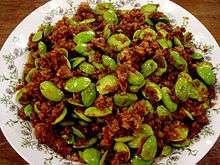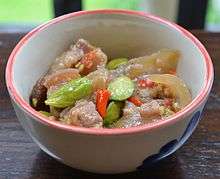Parkia speciosa
Parkia speciosa (the bitter bean, twisted cluster bean, or stink bean) is a plant of the genus Parkia in the family Fabaceae. It bears long, flat edible beans with bright green seeds the size and shape of plump almonds which have a rather peculiar smell, similar to, but stronger than that of the shiitake mushroom, due to sulfur-containing compounds also found in shiitake, truffles and cabbage.[1]
| petai or Sato | |
|---|---|
| Seed pods of P. speciosa | |
| Scientific classification | |
| Kingdom: | |
| (unranked): | |
| (unranked): | |
| (unranked): | |
| Order: | |
| Family: | |
| Genus: | |
| Species: | P. speciosa |
| Binomial name | |
| Parkia speciosa | |


Botanical description
The petai tree can grow to about 30 metres. It bears flowers in a light bulb-shaped mass at the end of long stalks. The flowers secrete a nectar that attracts bats and other pollinators. The fruits emerge as long, twisted, translucent pods in a cluster of seven or eight pods. When those pods are mature, within them will reside the petai beans or seeds.[2]
Use in cooking
The beans of other Parkia species (Parkia javanica and Parkia singalaris for example) are also popular as culinary ingredient in Indonesia, Malaysia, Singapore, Brunei, Laos, southern Thailand, Burma, and northeastern India specially Nagaland,Manipur and Mizoram, and are sold in bunches, still in the pod, or the seeds are sold in plastic bags. Pods are gathered from the wild, or from cultivated trees: they are exported in jars or cans, pickled in brine, or frozen.[3]
It is known as petai, pete in Indonesia, Malaysia and Singapore. In marketplace, depending on the country of origin Parkia species may be labelled wakerec, petai, yongchak, in Thadou Jonglha (pronounced zong-lha). They are best when combined with other strongly flavoured foods such as garlic, chili peppers, dried shrimp or shrimp paste, as in sambal petai. When young, the pods are flat because the seeds have not yet developed, and they hang like a bunch of slightly twisted ribbons, pale green, almost translucent. At this stage they may be eaten raw, fried or pickled. Young tender pods with undeveloped beans can be used whole in stir-fried dishes.[4]
The seeds are also dried and seasoned for later consumption. When dried the seeds turn black. Petai beans or seeds look like broad beans. Like mature broad beans, they may have to be peeled before cooking. Petai has earned its nickname 'stink bean' because its strong smell is very pervasive. It lingers in the mouth and body. Like asparagus, it contains certain amino acids that give a strong smell to one's urine, an effect that can be noticed up to two days after consumption. Like other beans, their complex carbohydrates can also cause strong-smelling rectal gas.
Indonesia
In Indonesia, petai is very popular in the highlands of Java and Sumatra, especially among Sundanese, Minangkabau and many other people in different cultures of the island. In Sundanese cuisine petai might be eaten raw with sambal as part of lalab, fried or grilled. It also can be stir fried and mixed with oncom. In Java and Sumatra, it also might be added to sayur lodeh or sambal goreng ati petai (fried diced beef or chicken liver in sambal and petai). Nasi goreng kambing petai is popular variant of nasi goreng (fried rice) with goat meat and petai. In Minangkabau cuisine it usually become part of lado (Minang sambal) for ayam pop (Padang style fried chicken).
India
In Manipur, it is grown mainly on all the hilly districts especially Kuki inhabited areas, who called it Jonglha, Hmar tribes call it Zawngṭa It is grown in the hill district of Hmârbiel and some other parts of Manipur valley. Varieties found here are somewhat harder than the counterparts of Thailand or Malaysia. The wild variety from the hills is more commonly sold in market. Some species of Parkia are grown in small scale by farmers in northeast India. In mainland India, it is grown as an ornamental plant, shade tree and border tree. This bean has become an important ingredient in many food items in Tripura too.
In Manipur, the seeds or the bean as a whole are eaten by preparing a local delicacy called Hmarcha dêng, Eromba or Yongchaak singju (salad).[5] Eromba is a very common cuisine in Manipur made with boiled potato, fermented fish, chili and other vegetables, in this case, Parkia. Yongchaak singju is another favourite side dish made with Parkia cut into small pieces and then mixed with red hot chili paste. Parkia is also used for making various other dishes with fish and vegetables.The Kuki Tribe,a tribe from North-East India, called it "Jonglha" and relished it with almost like a special vegetable. Rongmei Tribe of Manipur, Nagaland and Assam call it Kampai which is cooked with meat or prepared as salad, and sometimes seeds are eaten with Chattni made of dry fish. The Hmar tribe of Assam, Mizoram, Meghalaya, Manipur call it Zawngṭa (pronounced Zongtra) and mainly prepare it with chilli, Sodium Bi-carbonate, little amount of salt and a special fermented pork called "Saum"(sa means meat,um means fermented) and called it Zawngṭa-râwt.
In Mizoram, the Mizo people are also very fond of it, and call it Zawngṭah and they use to prepare it with chili and a fermented pork called Saum which is the same as 'sathu' of Manipur. In Manipur, Assam, Tripura, the (Tripura people call it Wakerec mosedang) and Bangladesh Manipuris call it Yongchak or wakerec in the local manipuri dialect and consume it as a salad mixed with fermented fish or, the boiled or roasted seeds either alone or in a mash of boiled vegetables laced with fermented fish.
Malaysia & Singapore
In Malaysia and Singapore, petai is also commonly served with sambal, or mixed with dried shrimp, chili peppers, red onions, belacan (prawn paste), soy sauce and prawn.
Thailand
In Thailand it is called sah-taw (Thai: สะตอ), as mu phat sah-taw, stink bean with stir fried pork.
References
- Frérot, Eric; Velluz, Alain; Bagnoud, Alain; Delort, Estelle (2008). "Analysis of the volatile constituents of cooked petai beans (Parkia speciosa) using high-resolution GC/ToF–MS". Flavour and Fragrance Journal. 23: 434–440. doi:10.1002/ffj.1902. Retrieved 22 May 2020.
- "Parkia speciosa". PlantUse. Retrieved 25 July 2017.
- The Stink Bean – A Little Smelly, A Lot of Flavor by Mark Wien in Migrationology
- Robinson, Kristy. "How to Cook Petai". Our Everyday Life. Retrieved 25 July 2017.
- Spicy Manipuri Salad in The Taste of Food
External links
| Wikimedia Commons has media related to Parkia speciosa. |